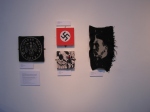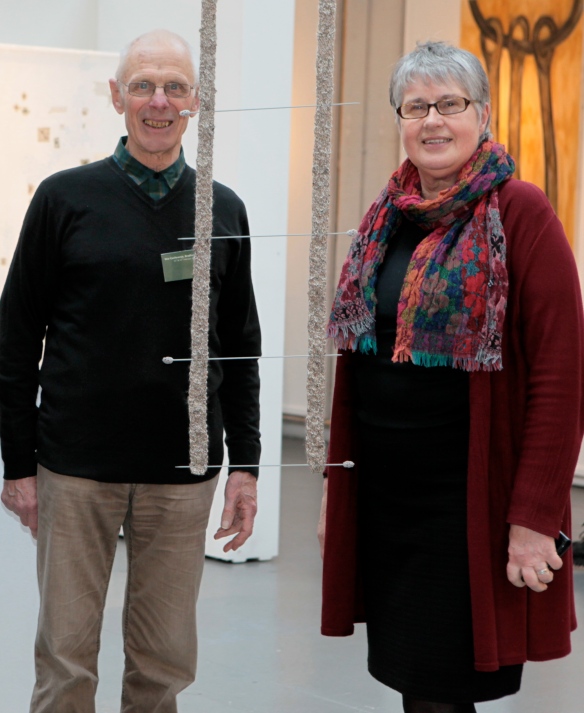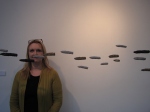Helen Farrar is a textile artist who took part in the three week exhibition on Art and War at Bradford College, February 2013. For her day job, Helen manages our Textile Archive, with more than 100 years of sample fabrics, designs, pattern books and other artefacts created by students and staff.
“When the opportunity arose to be part of an exhibition about war, I was interested straight away. I’ve always been interested in espionage: the hidden, the devious, strategy and game playing. So to prepare for the exhibition I began talking to people – and found that the contemporary instantly-recognisable representation of the spy is the fictitious James Bond.
“And not many could name a female secret agent, other than Mata Hari. I found that women who spy are perceived as glamorous sex objects. But in reality it is a dangerous, responsible and complex role. As a feminist I was concerned about this distortion.
“I researched both World War 2 and contemporary spies and discovered that many of them had quite shady pasts. This led me to consider motivation irrespective of gender; some do it for money, others because of a fundamental belief or cause. Some seemed to be able to detach themselves from their task – it seems that the most successful spies are cold and unemotional.
“As a textile artist specialising it knit, my medium and therefore my work is associated with comfort and warmth. I thought about infiltration – and how a spy uses stealth to fit in and appear comfortable to be accepted by the enemy. They go ‘under cover’, and disguise themselves to win trust. I wanted to work with this sense of duplicity and contradiction.”
 A collection of textile-based images are on one wall. “These explore different themes. One is based on Eddy Chapman, a British born world war two spy motivated by money. He was a double agent, awarded the Iron Cross for his work for the Nazis.”
A collection of textile-based images are on one wall. “These explore different themes. One is based on Eddy Chapman, a British born world war two spy motivated by money. He was a double agent, awarded the Iron Cross for his work for the Nazis.”
Another of the pieces is a knitted and felted portrait of Hitler. “These wall images are particularly difficult. I would never sell them, because I do not want to profit from the war. But also they are not about glorification – I don’t want them to be interpreted inappropriately”
One piece, very popular with visitors, is an installation of small, suspended crocheted bullets. “I saw the bullet as a metaphor for intelligence; espionage; information. I see intelligence as a weapon, as deadly as the ‘bullet’ it triggers.”
There is also a computer hard-drive on display, with two small crocheted bundles of wool. “This is about contemporary espionage. I was intrigued by the story of Shakil Afridi, the doctor and CIA collaborator who collected DNA samples routinely in his work, to establish the location of bin Laden. It’s unclear whether he knew or even guessed the objective of his quest. I considered using test-tubes, but substituted them for the computer hard-drive, the medium so many people use as a work tool.
 “This is a case study I would like to research further. Nowadays, so much of our lives depend on computers. We leave such a trail in the computer, but how much is protected, keeping information encrypted and secret, and how much is open to espionage? The crochet comprises wool with copper wire which symbolises a Faraday cage and stealth, yet duplicitously suggests conductivity of information.
“This is a case study I would like to research further. Nowadays, so much of our lives depend on computers. We leave such a trail in the computer, but how much is protected, keeping information encrypted and secret, and how much is open to espionage? The crochet comprises wool with copper wire which symbolises a Faraday cage and stealth, yet duplicitously suggests conductivity of information.
“My final piece is homage to ex Bradford College lecturer and peace campaigner Michael Randle and his wife Ann Randle. The knitted ladder using size 13 needles as rungs references their part in cold war spy George Blake’s successful escape from Wormwood Scrubs in 1966. Randle’s intervention, like my own, in no way condones espionage. The highlight of the whole exhibition, for me, was meeting Michael and Ann, and having their photo taken looking at my work.”

Michael and Ann Randle view work by artist Helen Farrar that marks the escape of spy George Blake from prison, at an exhibtion exploring War and Art at Bradford College, 2013. The rungs of Blake’s escape ladder were size 13 knitting needles, provided by Randle and others. Photo by Andy Vaines.
Helen Farrar is Bradford College’s Curator of Textiles. She manages the College’s Textile Archive, which provides inspiration to our students, staff and many other researchers, artists and people with an interest in local and textile history.



